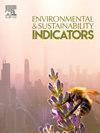Spatiotemporal dynamics of land surface phenology and its response to climate change in the upper Gelana watershed, northeastern highlands of Ethiopia
IF 5.4
Q1 ENVIRONMENTAL SCIENCES
引用次数: 0
Abstract
Land surface phenology (LSP) is a crucial indicator of climate change and its impact on ecosystems. Therefore, this study was carried out to assess the spatiotemporal variations in LSP and its response to climate change across the agroecological zones (AEZs) of the upper Gelana watershed in the northeastern highlands of Ethiopia. The LSP metrics were derived from MODIS NDVI data using TIMESAT v3.3, and trends as well as correlations were analyzed using the statistical programming language R. The results indicate that the dega AEZ exhibits an earlier start of the season (SOS) and a longer length of the season (LOS) compared to the lower and upper weina dega (LWD and UWD) AEZs. A delay in SOS and end of season (EOS) was observed in 71.3% and 82% of the study area, respectively, while LOS increased in nearly half of the area. There is a positive correlation between SOS and maximum temperature, and a negative correlation with belg season rainfall and drought indices in large parts of the study area. Similarly, EOS exhibits a direct association with kiremt season maximum temperature, rainfall, and drought indices. Furthermore, a shorter LOS is associated with a higher annual maximum temperature, while a longer LOS is associated with the increasing trend in annual rainfall. These findings will help raise awareness on climate change adaptation activities, including crop diversification, alteration of planting dates, soil conservation, water harvesting and irrigation, particularly within rural communities of the study area that rely heavily rely on rainfed agriculture.
求助全文
约1分钟内获得全文
求助全文
来源期刊

Environmental and Sustainability Indicators
Environmental Science-Environmental Science (miscellaneous)
CiteScore
7.80
自引率
2.30%
发文量
49
审稿时长
57 days
 求助内容:
求助内容: 应助结果提醒方式:
应助结果提醒方式:


